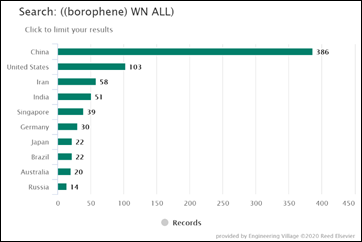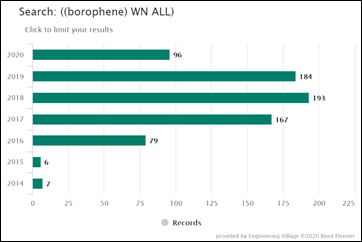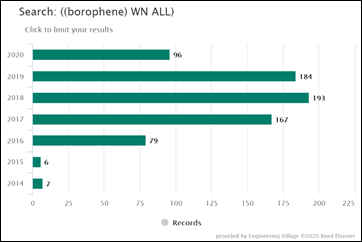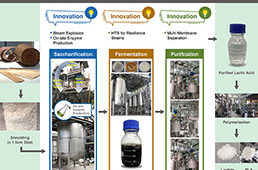By Chris Cogswell, customer consultant and Kane Gu, product manager
Elsevier
 When it comes to the materials we use in industry and daily life, we’re facing a range of new challenges — from shortages to environmental issues, to the need for new materials to support technology innovation. On top of this, consumer awareness is on the rise, as shown by the backlash against single-use plastic consumption and concerns about shortages of lithium used in batteries.
When it comes to the materials we use in industry and daily life, we’re facing a range of new challenges — from shortages to environmental issues, to the need for new materials to support technology innovation. On top of this, consumer awareness is on the rise, as shown by the backlash against single-use plastic consumption and concerns about shortages of lithium used in batteries.
All of these factors exacerbate the need to discover and synthesize new materials, successfully recycle existing materials and find new applications for, and enhance, existing materials. In fact, advances in materials could be vital to solving many of the problems facing scientists in 2020 and beyond, including:
• Materials shortages: Industries rely heavily on existing materials that we are already running short of, such as indium which is used in flat screens and solar cells.
• Environmental issues: We are seeing a movement towards reusing materials to reduce waste and combat shortages. For example, the 1.5 billion smartphones built each year have around $150 million of materials which could be reclaimed.
• New technology: As technology advances, we need new developments in materials to support the widespread use of this tech, like the new infrastructure needed before a successful roll-out of 5G globally.
• Storing green energy: With the global energy industry looking to more sustainable resources, we need materials capable of storing surplus energy, much like Tesla’s giant battery in Australia.
• Mitigating human impact: There has been significant backlash against the amount of plastic consumers encounter every day, so finding more sustainable or recyclable materials to replace the use of plastic is a global challenge.
In the race to make things stronger, lighter, cost-effective, functional and/or sustainable, the modification of materials, their properties and processes is key. The last 20 years shows a significant upward trend in materials research (Figure 1).
New ‘wonder materials’
In the past decade, we’ve begun to see the potential of ‘wonder material’, graphene. Elsevier’s Abstract and citation database, Engineering Village, shows graphene was cited 15-times more in 2018 (21,649 citations) than in 2008 (1,364 citations). This research shows the ‘wonder material’ has wide-ranging possibilities with its potential uses, including: eliminating rust, creating ‘greener’ concrete and even offering targeted drug delivery.
Interest in another ‘wonder material’, borophene, has also intensified. According to Engineering Village, the material was cited a mere three times in 2014 (Figure 2a), the year before it was first synthesized, compared to 77 times in 2019, with total number of published articles increasing from 7 to 184 during the same time period. (Figure 2b). Much like graphene, borophene’s uses are extremely varied, with its potential as a superconductor making it a likely component in the next generation of wearables, biomolecular sensors and quantum computers.
The discoveries of graphene and borophene have also opened new routes for materials science, generating new interest in two-dimensional materials and providing a timely reminder that materials innovation is possible.
R&D in China
The Chinese materials sector is a prime example of innovation in materials science and is subsequently influencing the global research landscape. Of all the research about graphene cited in Engineering Village, for example, the vast majority (56,485) have predominantly come from China; with 22,342 from the US, 10,159 originating from South Korea and 8,813 from India (Figure 3).
We see a significant amount of materials research originating from, and funded by, China for several reasons. First, universities and industry in the region focus heavily on R&D: BASF, for example, aims to have 3,500 researchers based in Asia, predominantly China, by 2020. Second, there is significant investment in STEM, as well as government subsidies for research. Third, some of the key industry sectors in China, like textiles, are looking for solutions to their biggest issues, such as securing sufficient quality raw water for water-intensive industries. Materials solutions that benefit their biggest industries will likely have a subsequent global impact.
While there is materials R&D globally, the conditions within China have generated the perfect environment for materials science to thrive in the country. As these developments start to be built on around the world, scientists need to be able to keep pace to reap the benefits of the progress in materials science.
Striking a new gold
To find solutions to the global challenges we’re facing, advance our knowledge of existing materials and synthesize new materials, we need to continue our focus on research and development in materials science. We have an abundance of materials data available and with scientific datasets currently doubling every nine years, there’s undoubtedly much more to come. Data-driven research offers real potential for materials to solve some of the global challenges we’re facing. To keep pace with current advances in materials science, researchers need access to these datasets.
As well as making discovery quicker, investing in access to data ensures researchers’ time is spent more effectively, data isn’t duplicated and opportunities to collaborate are highlighted. The first papers about borophene, for example, were a collaboration between scientists in China and the US (Figure 4). While, affording access to all relevant materials data may seem like a large investment, it is becoming increasingly necessary. We’re reaching the defining moment for some of the scientific challenges we face and the only way for us to find material solutions to these issues is to work quickly, and to work together.

Figure 1, Source: Engineering Village (16 July 2020)

Figure 2a, Source: Engineering Village (16 July 2020) – total articles published

Figure 2a, Source: Engineering Village (16 July 2020) – total articles published

Figure 2a, Source: Engineering Village (16 July 2020) – total articles published

Figure 3, Source: Engineering Village (16 July 2020)

Figure 4, Source: Engineering Village (16 July 2020)





Tell Us What You Think!